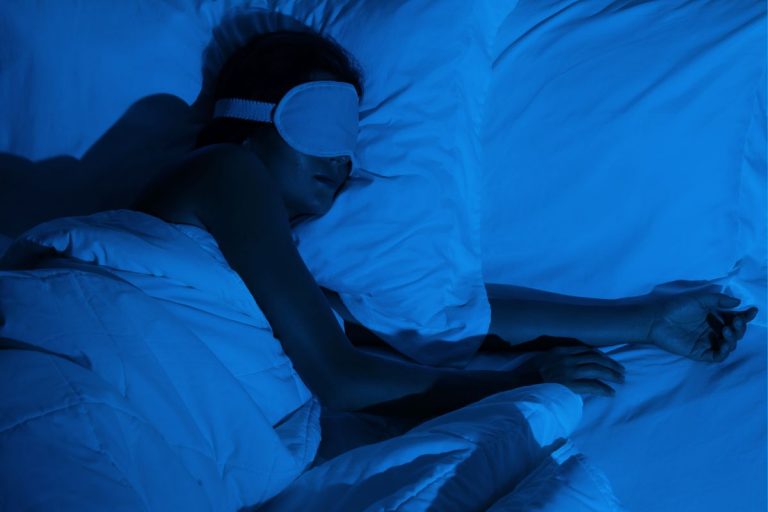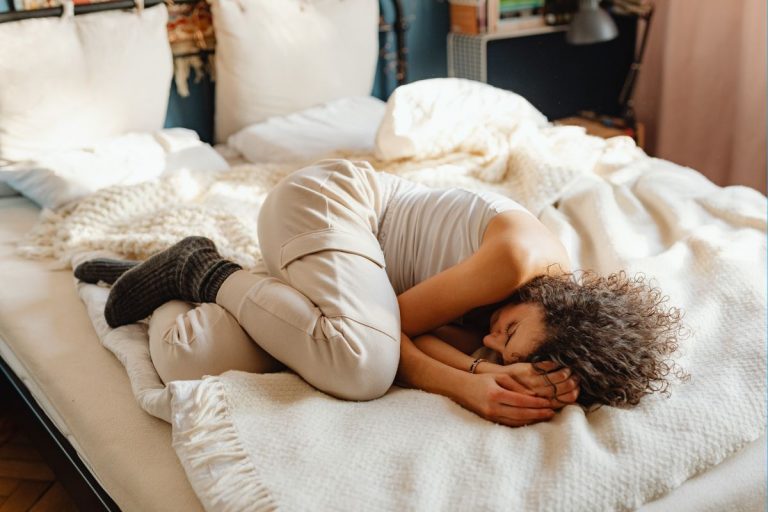A ruptured eardrum is usually only painful for those first few minutes and if it’s not, then you should read our section on symptoms below. But just because the pain and symptoms only last a short while doesn’t mean that you’re safe to go about life like normal as it heals.
In fact, there are several precautions you should take when you have a ruptured eardrum. Your sleeping position is one of the most important. Whether you have just one perforated eardrum or two, your sleeping position can have a big impact on your recovery.
This quick and easy guide will explain how to sleep with a ruptured eardrum and what to avoid doing as it heals!
How to Sleep on a Ruptured Eardrum: Should You Sleep On The Side?
When your eardrum is ruptured, there’s much that you can do besides wait for it to heal. You’ll only need to take medication if you’re in pain or develop an ear infection – see symptoms below.
But that doesn’t mean sleeping is an easy affair. When you tilt your head down or shift position, you apply pressure onto your ear. If you’re in the early stages of a ruptured eardrum, it may be leaking fluid over your pillow too.
That’s why the best position to sleep in with a ruptured eardrum is on your back, with your head propped up on pillows.
Why? Because;
- This position doesn’t put pressure on either of your ears,
- Elevating your head above your body reduces blood pressure further,
- Fluid won’t get trapped in your ears overnight and can flow out.
Keeping your ears clean and dry is important. Place a towel on your pillow to catch any fluid and try to avoid rolling onto one side during the night.
Advice for Side Sleepers
If sleeping on your back is just impossible then you can try sleeping on your side. The key is that you must sleep with your good ear pressed into the pillow and your perforated eardrum ear exposed to the room.
It will be hard for fluid to leak out in this position, as you’re working against gravity. But you won’t be putting any pressure on that ear so it won’t be painful or heed your recovery.
When sleeping on your side, it’s not a good idea to elevate your head with many pillows, even though this was our advice for back sleepers. This diagram shows why:
This is uncomfortable and may hurt your neck. Sleeping on your side like this over the long term may lead to back pain too.
Why This is Important
How you sleep is so important because we spend 8 hours asleep each day (or we should, at least). This is one third of the entire day! If we spend it with our ruptured eardrum under pressure, or clogging up with fluid, it is going to take much longer to heal by itself. In the worst-case scenarios, it could lead to an infection.
So, make sure that your bedding is clean and your look after your perforated eardrum!
Ruptured Eardrum Symptoms to Watch Out For
As you don’t always need medication to treat and heal a perforated eardrum, you might be thinking that you can avoid a trip to the doctors! But we highly recommend that you seek medical help if you have any of the symptoms of a perforated eardrum:
- General discomfort in one ear that isn’t going away,
- Air that rushes out of one ear when you blow your nose,
- Building pressure in one ear that suddenly releases,
- Hearing loss in one ear,
- Blood, puss or just clear fluid leaking from one ear,
- Unexplained noises in one ear, like buzzing or static.
You might have a few symptoms, but it’s also possible that you’ll have no symptoms at all. Another sign of a ruptured eardrum is recurring ear infections.
If you have any of these symptoms, we recommend going to see a doctor for an otoscopic exam and asking them for advice on treatment. They’ll also be able to tell you what they personally recommend when it comes to sleeping with a ruptured eardrum.
Ibuprofen is usually the medication of choice if you are in pain. A perforated eardrum is rarely painful enough to warrant prescribed painkillers… unless you have an ear infection.
Ear Infections
If you’ve been sleeping in the wrong position or dirt has got into your ear, the ruptured eardrum could lead to an ear infection. Unlike a simple perforation of the eardrum, an infection may not just go away by itself. You definitely need to seek medical attention. If you experience any of these symptoms, you should book an appointment with a medical health professional ASAP:
- Itchy, painful and uncomfortable ears,
- Dizziness and fever-like symptoms,
- Blocked nose and cold and flu symptoms.
Sometimes the ear infection comes first – the build up of the infection puts pressure on the eardrum until it bursts – so many cases of ruptured eardrums can be avoided by taking better care of your ears!
3 More Things to Do When Your Eardrum Ruptures
Studies have shown that eardrum ruptures will heal themselves, and your doctor can confirm this. But there are still some things you can do to prevent and treat a ruptured eardrum at home.
Sleeping on your back or with your good ear to the pillow is great for overnight, but during the day, you can try:
- Coating a cotton ball in petroleum jelly (Vaseline) and gently placing it in your ear while you bathe or shower. This will prevent water getting into your ear, which is important for the healing process.
- Keep things quiet. Exposing your ears to very loud noises isn’t going to help them heal and will also cause discomfort. You don’t need to take a vow of silence, but don’t blast your music at full volume either!
- Use warmth to combat earache and soothe discomfort. Place a cloth on a radiator or anywhere else in your home that gets warm. When the material is warm enough, place it on your ear. Remember not to use a wet cloth though.
You should also avoid sleeping with an electric blanket or cloth on your ear. Exposing it to the air is best to let it heal natural, and you risk getting burned by having an electric blanket directly on your skin overnight.
Other things to avoid:
- Wearing ear plugs or in-ear headphones.
- Swimming, obviously!
- Cleaning your inner ear with Q-tips – you should never do this, even when your ears are healthy.
- Applying herbal oils and remedies that fight infection and clear out wax. These may work if you have a simple infection, however a ruptured eardrum is best kept dry unless otherwise directed by your physician (they may prescribe antibiotic eardrops).
FAQs
How to sleep with a ruptured eardrum?
The best way to sleep with a ruptured eardrum is on your back, with your head elevated. This helps it drain naturally and won’t put pressure on it. If you can only sleep on your side, sleep with your good ear pressed to the pillow and your ruptured eardrum facing the ceiling.
What should I do if I have a ruptured eardrum?
Talk to your doctor if you are in pain or believe that the rupture was caused by an infection – they will do an examination to diagnose the rupture and prescribe medication.
Otherwise, a ruptured eardrum will heal itself within a few weeks. The important things to do are sleep elevated, keep it clean and dry, protect the ear from cold air.
Which side do I lay on to drain my ear?
If your ear is infected on the eardrum is perforated, sleeping with that ear pressed to the pillow will help it drain… but it also applies pressure, which can be quite painful. Sleeping with your good ear to the pillow will relieve that pressure in the bad ear but won’t help it drain so well.
The best position for draining a leaky ear is on your back, with your head propped up with multiple pillows to keep it elevated.
How should I sleep when my ears are draining?
When you have a ruptured eardrum, it may leak or drain some fluid. This can be clear, pus-like, or even a little bloody. It’s important that you let the fluid drain out naturally during the day and overnight, so sleep with your head on some extra pillows to keep it elevated. Lay down a towel if the liquid leaks out onto your pillow. Avoid sleeping on your side.
How long will a ruptured eardrum leak for?
A ruptured eardrum can take up to 3 months to heal fully – if the ear becomes infected, it can take even longer and will require medical attention. Most cases will heal up in a few weeks. The leaking won’t last long if the rupture was caused by trauma (e.g., jabbing your finger in there to get out wax) but if it continues for days and is accompanied by pain and other symptoms, the leaking may be caused by an infection, so see your doctor about treatment.
How painful is a ruptured eardrum supposed to be?
A ruptured eardrum may be painful on the moment it ruptures, like a big bang in one (or both) ears. But once your hearing has gone, the rupture can be quite painless. Most people will only experience a mild discomfort at times, as the rupture heals… but this can take up to 3 months, so during that time you need to take precautions, including how you sleep.
Also Read:





